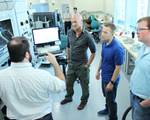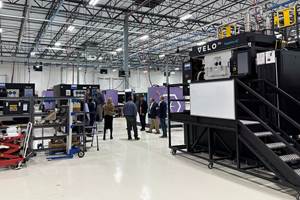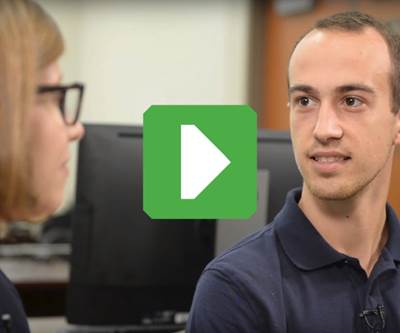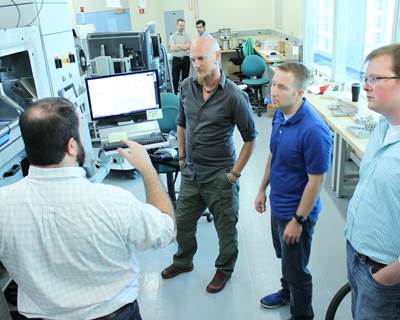Video: Inside the Penn State Additive Manufacturing Master's Program, Part 2
A conversation with Brad Hanks, Ph.D. student at Penn State University, illustrates the intersection of optimization and AM with the example of an electrode for cancer treatment surgery.
Additive manufacturing (AM) means design freedom, but AM alone won’t provide the best design. For that, AM needs optimization—ways of reimagining designs and then validating those redesigns. In turn, optimization stands to benefit from additive, a means of manufacturing optimal shapes regardless of complexity.
That interplay is what drew Brad Hanks to additive manufacturing. Hanks is a Ph.D. candidate in mechanical engineering also pursuing a minor in AM at Penn State University. When I spoke with him about this connection, he shared an illustration from his research: a 3D-printed surgical electrode that could be customized to target the exact size and shape of a patient’s tumor. Watch the video below or read on for the transcript.
Video Transcript
Stephanie Hendrixson, Additive Manufacturing Magazine
I’m Stephanie Hendrixson with Additive Manufacturing Magazine, and I'm here at Penn State talking to students in their graduate program in additive manufacturing and design. Many of the students in this program are pursuing a master's degree in additive manufacturing, while others are taking these classes to augment their other studies. Here with me is Brad Hanks, a graduate research assistant pursuing a Ph.D. in mechanical engineering with a minor in additive manufacturing. What has the experience in this program been like so far?
Brad Hanks, Graduate Student
In the classes I've been able to learn a lot about a variety of different topics from material science which I haven't done for many years, trying to understand the science of what's happening in an additive process and also considering design. It becomes almost a new method of thinking when you consider additive manufacturing (AM) is very different than conventional manufacturing processes.
One thing that I'm starting to look into more is the microstructure, or even the mesostructure, of the material and in conventional manufacturing you wouldn't consider that, because manufacturing it at that level would often increase the complexity beyond what is reasonable. In additive manufacturing, there's a certain freedom that allows you to manufacture at the smaller scale and increase the complexity of a part without directly increasing the cost of the part. That allows you to design at multiple length scales rather than just the bulk geometry of the part. You can include complexities at a smaller scale without increasing your cost.
Stephanie
As a student in residence on the campus, you've had the opportunity to do some research with faculty in the AM program. Talk to me about the research that you're working on in the medical device field.
Brad
Sure. One of the first projects I worked on was a radio frequency ablation electrode. In radio frequency ablation, the shape of the electrode determines the shape of the treatment zone. Specifically for endoscopic treatments, there's a limited selection of electrodes to treat tumors. So, my first project was working on a medical-surgical tool where we could use optimization to adjust the shape of the electrode to match the shape of the tumor. This is one of the prototypes that we made using additive manufacturing.
A lot of the work that I did was on the optimization side: How do we optimize the shape or the size of the electrode? Then the ability to use additive manufacturing allows us to now make these custom parts manufacturable because of the cost. If we only had a single size electrode that we were doing, then it's probably cheaper to go with other manufacturing processes, but in the case of the optimization software where we're looking at customizing the shape of the electrode for a specific treatment zone, then we're making one-off components or customized components personalized to a patient, for example. And so, additive manufacturing allows us to create custom components that can be used for a specific patient.
This one is about three times’ scale. The outer sheath here represents an endoscopic needle which is roughly about a millimeter in outer diameter, or it would be. This outer needle can be introduced up to the edge of a tumor and then the electrode would be deployed from the end of that needle into the tumor. So that's how this device would function and then the optimization works to choose the size and shape of your electrode to customize it for your treatment.
Stephanie
And so the actual 3D-printed part here are these tines at the end of the device, correct?
Brad
Yeah. So, this is the only 3D-printed portion of it, which is the customized portion of the electrode.
Stephanie
What would that be printed out of and what type of process would you make it with?
Brad
This prototype is printed out of Inconel which is not a biocompatible material. The final product would need to be either stainless steel or other biocompatible material. The nickel content in the Inconel is too high. The process that we used to manufacture this was powder-bed fusion.
Stephanie
Given the research that you've done and the coursework you've completed, what is the potential for AM in the medical industry?
Brad
There are a lot of challenges that come along with additive in the medical field. Being able to validate components and parts is a big area, but the biggest potential I see is being able to create custom parts for patients. Whether that's an implant or a surgical device, these can be customized and manufactured at a cost that's available or reasonable for a custom part, whereas before, it would be prohibitively expensive to manufacture a custom medical implant.
Stephanie
How are you hoping to apply your knowledge about AM after completing your degree?
Brad
Really being able to use optimization to learn how to use AM. There's a lot of design freedom in AM and I don't think we have a good idea really of how to use it all yet. I think that's where a critical crossover happens between optimization and AM. I think really being able to combine these tools will help us learn how to take full advantage of AM.
Related Content
Zeda AM Production Plant in Ohio Now Open — Thoughts on the New Facility
73,000-square-foot metal powder bed fusion plant includes extensive machining capability plus separate operational models for serving medical versus other businesses.
Read MoreQ&A With Align EVP: Why the Invisalign Manufacturer Acquired Cubicure, and the Future of Personalized Orthodontics
Align Technology produces nearly 1 million unique aligner parts per day. Its acquisition of technology supplier Cubicure in January supports demand for 3D printed tooling and direct printed orthodontic devices at mass scale.
Read MoreActivArmor Casts and Splints Are Shifting to Point-of-Care 3D Printing
ActivArmor offers individualized, 3D printed casts and splints for various diagnoses. The company is in the process of shifting to point-of-care printing and aims to promote positive healing outcomes and improved hygienics with customized support devices.
Read MoreCranial Implant 3D Printed From Hydroxyapatite Ceramic: The Cool Parts Show #76
Cranial implants are typically made from titanium or PEEK; in this episode of The Cool Parts Show, we look at how implants made from a bioceramic can improve osseointegration and healing.
Read MoreRead Next
Video: Inside the Penn State Additive Manufacturing Master's Program, Part 4
Kevin White, mechanical engineer at the Naval Nuclear Lab and student at Penn State, shares how a higher education in AM provides benefits beyond technical training.
Read MoreVideo: Inside the Penn State Additive Manufacturing Master's Program, Part 3
Alan Suarez Garcia, advanced manufacturing engineer at GE Healthcare and master's student at Penn State, explains how this degree program changes how he looks at manufacturing.
Read MoreInside the Penn State Additive Manufacturing Master’s Program, Part 1
PSU's engineering master's degree in additive manufacturing and design offers students and manufacturing professionals a higher education in a continuously maturing field.
Read More
.jpg;width=70;height=70;mode=crop)




















